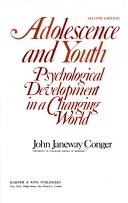| Listing 1 - 10 of 295 | << page >> |
Sort by
|
Book
ISBN: 0128154500 9780128172544 9780128154502 0128172541 Year: 2020 Publisher: London
Abstract | Keywords | Export | Availability | Bookmark
 Loading...
Loading...Choose an application
- Reference Manager
- EndNote
- RefWorks (Direct export to RefWorks)
Adolescence. --- Teen-age --- Teenagers --- Puberty --- Development

ISSN: 11599642 ISBN: 2220033848 9782220033846 Year: 1993 Publisher: Paris: Desclée De Brouwer,
Abstract | Keywords | Export | Availability | Bookmark
 Loading...
Loading...Choose an application
- Reference Manager
- EndNote
- RefWorks (Direct export to RefWorks)
Gangs --- Teenagers --- Adolescents --- Teen-agers --- Teens --- Young adults (Teenagers) --- Crews (Gangs) --- Crime syndicates --- Street gangs --- Teen gangs --- Teenage gangs --- Youth --- Criminals --- Juvenile delinquents --- Hoodlums --- Gangs - France. --- Teenagers - France.

ISBN: 1107131790 1280419342 0511613814 0511177887 0511042027 0511148399 051130529X 0511044798 9780511042027 9780511148392 9780511044793 9780511177880 9780521809108 052180910X 0521006058 9780521006057 9780511613814 9786610419340 6610419345 9781107131798 9781280419348 Year: 2002 Publisher: Cambridge : Cambridge university press,
Abstract | Keywords | Export | Availability | Bookmark
 Loading...
Loading...Choose an application
- Reference Manager
- EndNote
- RefWorks (Direct export to RefWorks)
The life stage of adolescence now occurs in most corners of the world, but it takes different forms in different regions. Peers, with such a central role in Western adolescence, play a comparatively minor role in the lives of Arabic and South Asian adolescents. Emotional turmoil and individuation from family occur in some societies but not others. Adolescent sexual revolutions are sweeping through Japan and Latin America. In this 2002 book, scholars from eight regions of the world describe the distinct nature of adolescence in their regions. They draw on research to address standard topics regarding this age - family and peer relationships, schooling, preparation for work, physical and mental health - and show how these have a different cast across societies. As a whole, the book depicts how rapid global change is dramatically altering the experience of the adolescent transition, creating opportunities and challenges for adolescents, parents, teachers, and concerned others.
Adolescence --- Youth --- Teenagers --- Adolescents --- Teen-agers --- Teens --- Young adults (Teenagers) --- Teen-age --- Puberty --- Development --- #PBIB:2003.3 --- Health Sciences --- Psychiatry & Psychology
Book
ISBN: 1479814407 1479833592 9781479833597 9781479815586 1479815586 Year: 2015 Publisher: New York, NY : New York University Press,
Abstract | Keywords | Export | Availability | Bookmark
 Loading...
Loading...Choose an application
- Reference Manager
- EndNote
- RefWorks (Direct export to RefWorks)
Explores the shifts and the research used to support civil rights claims of discrimination, particularly relating to minority youths’ rights to equal treatment In the wake of the civil rights movement, the legal system dramatically changed its response to discrimination based on race, gender, and other characteristics. It is now showing signs of yet another dramatic shift, as it moves from considering difference to focusing on neutrality. Rather than seeking to counter subjugation through special protections for groups that have been historically (and currently) disadvantaged, the Court now adopts a “colorblind” approach. Equality now means treating everyone the same way. This book explores these shifts and the research used to support civil rights claims, particularly relating to minority youths’ rights to equal treatment. It integrates developmental theory with work on legal equality and discrimination, showing both how the legal system can benefit from new research on development and how the legal system itself can work to address invidious discrimination given its significant influence on adolescents—especially those who are racial minorities—at a key stage in their developmental life. Adolescents, Discrimination, and the Law articulates the need to address discrimination by recognizing and enlisting the law’s inculcative powers in multiple sites subject to legal regulation, ranging from families, schools, health and justice systems to religious and community groups. The legal system may champion ideals of neutrality in the goals it sets itself for treating individuals, but it cannot remain neutral in the values it supports and imparts. This volume shows that despite the shift to a focus on neutrality, the Court can and should effectively foster values supporting equality, especially among youth.Explores the shifts and the research used to support civil rights claims of discrimination, particularly relating to minority youths’ rights to equal treatment In the wake of the civil rights movement, the legal system dramatically changed its response to discrimination based on race, gender, and other characteristics. It is now showing signs of yet another dramatic shift, as it moves from considering difference to focusing on neutrality. Rather than seeking to counter subjugation through special protections for groups that have been historically (and currently) disadvantaged, the Court now adopts a “colorblind” approach. Equality now means treating everyone the same way. This book explores these shifts and the research used to support civil rights claims, particularly relating to minority youths’ rights to equal treatment. It integrates developmental theory with work on legal equality and discrimination, showing both how the legal system can benefit from new research on development and how the legal system itself can work to address invidious discrimination given its significant influence on adolescents—especially those who are racial minorities—at a key stage in their developmental life. Adolescents, Discrimination, and the Law articulates the need to address discrimination by recognizing and enlisting the law’s inculcative powers in multiple sites subject to legal regulation, ranging from families, schools, health and justice systems to religious and community groups. The legal system may champion ideals of neutrality in the goals it sets itself for treating individuals, but it cannot remain neutral in the values it supports and imparts. This volume shows that despite the shift to a focus on neutrality, the Court can and should effectively foster values supporting equality, especially among youth.
Criminal justice, Administration of --- Teenagers --- Age discrimination --- Adolescence --- Adolescents --- Teen-agers --- Teens --- Young adults (Teenagers) --- Youth --- Teen-age --- Puberty --- Civil rights. --- Social aspects --- Development

ISBN: 006041362X Year: 1977 Publisher: New York Harper & Row
Abstract | Keywords | Export | Availability | Bookmark
 Loading...
Loading...Choose an application
- Reference Manager
- EndNote
- RefWorks (Direct export to RefWorks)
Developmental psychology --- Age group sociology --- Adolescence --- #GSDBP --- Teen-age --- Teenagers --- Puberty --- Development
Book
ISBN: 2130487653 Year: 1997 Volume: 29 Publisher: Paris : PUF - Presses Universitaires de France,
Abstract | Keywords | Export | Availability | Bookmark
 Loading...
Loading...Choose an application
- Reference Manager
- EndNote
- RefWorks (Direct export to RefWorks)
Adolescence --- Adolescent psychology --- Adolescents --- Psychologie --- Teenagers --- Psychology --- Teen-age --- Puberty --- Development --- Adolescence. --- Adolescent psychology.
Book
ISBN: 9781139042819 9780521768467 9781107423602 9781139127783 1139127780 9781139117128 1139117122 0521768462 9781139114950 1139114956 113912451X 1107225221 1283296004 113912286X 9786613296009 1139112767 1139042815 1107423600 9781107225220 9781283296007 6613296007 9781139112765 Year: 2011 Publisher: Cambridge : CUP,
Abstract | Keywords | Export | Availability | Bookmark
 Loading...
Loading...Choose an application
- Reference Manager
- EndNote
- RefWorks (Direct export to RefWorks)
This book explores the central importance of adolescents' own activities in their development. This focus harkens back to Jean Piaget's genetic epistemology and provides a theoretically coherent vision of what makes adolescence a distinctive period of development, with unique opportunities and vulnerabilities. An interdisciplinary and international group of contributors explore how adolescents integrate neurological, cognitive, personal, interpersonal and social systems aspects of development into more organized systems.
Adolescent psychology. --- Adolescence. --- Constructivism (Psychology) --- Psychology --- Teen-age --- Teenagers --- Puberty --- Adolescence --- Development --- Health Sciences --- Psychiatry & Psychology
Book
ISBN: 0309683351 0309683335 Year: 2020 Publisher: Washington, District of Columbia : National Academies Press,
Abstract | Keywords | Export | Availability | Bookmark
 Loading...
Loading...Choose an application
- Reference Manager
- EndNote
- RefWorks (Direct export to RefWorks)
Teenagers --- Medical care --- Mental health services --- Services for --- Adolescents --- Teen-agers --- Teens --- Young adults (Teenagers) --- Youth
Book
ISBN: 3038422959 Year: 2016 Publisher: Basel : MDPI - Multidisciplinary Digital Publishing Institute,
Abstract | Keywords | Export | Availability | Bookmark
 Loading...
Loading...Choose an application
- Reference Manager
- EndNote
- RefWorks (Direct export to RefWorks)
Annotation This collection provides a forum for leading scholars to examine theoretical insights and empirical findings associated with the recent decline in adolescent pregnancy and childbearing internationally, with special attention given to the United States. This recent shift in the incidence of adolescent fertility is notable in its consistency and magnitude; at the same time, however, continuing historic disparities require focused attention on the contemporary meaning of early childbearing in the U.S. as well as across the globe. The widely interdisciplinary contributions focus on demographic trends in adolescent fertility; successful intervention approaches and major "lessons learned" regarding primary pregnancy prevention; identification of key theoretical issues associated with these trends, with particular focus on the existence and meaning of disparities and their implications for youth development and wellbeing.
Teenage pregnancy. --- Adolescent pregnancy --- Pregnancy, Adolescent --- Pregnancy, Teenage --- Pregnancy in adolescence --- Teen pregnancy --- Pregnancy
Book
ISBN: 9781138681927 113868192X Year: 2019 Publisher: Abingdon, Oxon ; New York : Routledge,
Abstract | Keywords | Export | Availability | Bookmark
 Loading...
Loading...Choose an application
- Reference Manager
- EndNote
- RefWorks (Direct export to RefWorks)
Teen films --- Teenagers in motion pictures. --- History and criticism. --- Breakfast club (Motion picture)
| Listing 1 - 10 of 295 | << page >> |
Sort by
|

 Search
Search Feedback
Feedback About UniCat
About UniCat  Help
Help News
News